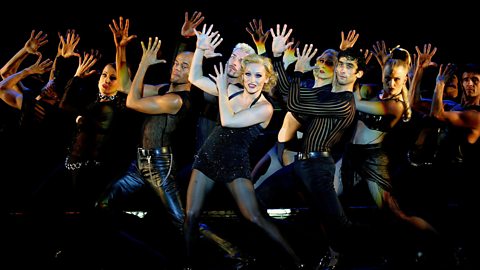Musical

A musical is a play performed on stage with costumes, scenery, dancing and props. Musicals are a development from the comic operas and mini operettas of the 18th Century.
They were also influenced by British music hall and American variety shows. Both these forms of entertainment gave people the chance to see a variety of singers and dancers on stage in a less formal setting and performing 'popular' music.
Some of the first opera composers would use pieces of popular music within their operas to make them more attractive to a public audience.
William Gilbert and Arthur Sullivan formed a partnership during the 1870s to compose a series of comic operettas - short opera like productions with arias, chorus and some spoken words.
The popularity of this new form of stage show led to a growing number of American composers creating to a series of glamorous stage productions that we now recognise as musicals.
Other famous early musical composers include:
- Jerome Kern
- Cole Porter
- Rogers and Hammerstein
Musicals featured catchy show melodies and accessible storylines of love, family and everyday life. This made them attractive to a large audience. Film, television and radio helped musicals reach a global audience.
Musicals have been written about many subjects but most often have a focus love and the relationships of the main characters:
- 'Mama Mia' and 'Grease' are, basically, love stories set in Greece and an American High School
- 'Les Miserables' is a story of family and love set around the time of the French Revolution
- 'West Side Story' updates the story of Romeo and Juliet to New York in the 1950s
- 'Evita' tells the life story of the Argentinian politician Eva PerУГn
Vocals and instruments
In a musical, songs will be intersperses with spoken dialogue. Unlike an opera, it is more common nowadays to have a band accompaniment rather than a full orchestra. This is because musicals are popular in style and require instruments such as keyboards, guitars, drum kits and saxophones.
The most popular musicals are sung in English by solo singers and a chorus. The solo singers have their own songs as well as duets and trios with other cast members. There will be a chorus who will join the stage for the bigger songs.
Musicals are another example of the SATB choir - sopranos, altos, tenors and basses. Performers will sing mostly in harmony and will often have to learn dances and movement as well as their lines of dialogue and song lyrics.
As in opera, if a female singer's voice comes somewhere in between a soprano and alto we call them a mezzo soprano.
A male singer whose voice comes somewhere in between a tenor and bass is a baritone.
The style of singing in a musical is very pop/rock and will include syllabic and melismatic word setting:
- To make a word sound confident and clear the music will have one note per syllable. This is called syllabic word setting.
- To highlight a word for dramatic effect more than one note is given per syllable so that the word lasts longer. This is called melismatic word setting.
Listen to this clip of Elaine Paige singing 'Memory' from the musical 'Cats' to hear an example of syllabic word setting.
'Memory' from 'Cats' performed by Elaine Paige
Structure
Songs in musicals are often strophic. Strophic songs have a verse and a chorus. The verse tells the story and has the same music each time. The chorus is a repeating section with the same music and lyrics each time. It is often more musically intense and 'catchier'.
Watch this film of Madonna in 'Evita' to hear an example of typical musical singing.
Madonna, playing Eva PerУГn in the musical 'Evita'
Listen to the style of accompaniment. The music is played at a steady pace - andante - with Madonna using syllabic singing to make her words more dramatic. The music makes use of dynamics such as crescendos, where the music gradually gets louder in order to make the music more expressive. The song also slows down with a rallentando and then picks up again with an a tempo that creates drama.